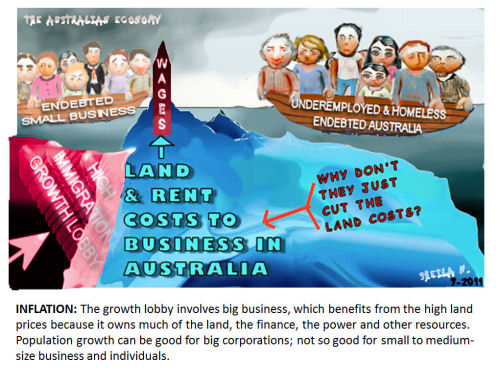Australia’s disgrace: the exploitation of foreign workers - Article by Leith van Onselen
The Senate Education and Employment References Committee has released a scathing report entitled A National Disgrace: The Exploitation of Temporary Work Visa Holders, which documents the abuses of Australia’s temporary visa system for
foreign workers.
By Unconventional
Economist in Australian Economy
at 7:11 am on March 30, 2016 | 93
comments
The Senate Education and Employment References Committee has
released a scathing report entitled A
National Disgrace: The Exploitation of Temporary Work Visa Holders,
which documents the abuses of Australia’s temporary visa system for
foreign workers.
According to the report, there are over 1.8 million temporary visa
holders in Australia (see Table 2.5 below), with approximately 1.4
million of them having work rights. This means that temporary visa
holders comprise around 10% of Australia’s labour force.
Below is a summary of the Committee’s view of the 457 visa system
for so-called “skilled” foreign workers:
The committee received evidence that a key indicator of the
effectiveness of the 457 visa program in addressing genuine skills
shortages is the responsiveness of the demand for 457 visa workers to
changes in the general rate of unemployment, and to changes in the
supply of skilled labour in particular occupations.Evidence to the committee indicated that the responsiveness of
the 457 visa program to the upturn in the unemployment rate lagged by
two to three years. Furthermore, the committee received evidence that
the 457 visa program was having a detrimental impact on the employment
opportunities for Australian graduates in specific occupations such as
engineering and nursing.The committee acknowledges that it received conflicting evidence
regarding the balance between permanent and temporary migration. In
theory, the value of temporary migration is that it allows business to
meet short-term skills shortages. In this respect, there is an
advantage in having some element of temporary migration because
addressing skills shortages solely through the permanent migration
scheme could result in a skills surplus, particularly if a sector that
was booming experienced a sudden down-turn (the resources sector for
example). Addressing short-term skill shortages with the 457 visa
scheme should be a way of moderating these types of rapid
transformations in discrete segments of the skilled job market.However, the committee is concerned that the broader temporary
visa program, and specifically the 457 visa program, is not
sufficiently responsive either to higher levels of unemployment, or to
labour market changes in specific skilled occupations…Given the concerns raised in this inquiry, it is therefore
appropriate to review the policy settings of the 457 visa program and
labour agreements at this juncture to ensure they are set correctly…
The Committee recommends that the minimum income threshold for 457
visa holders be indexed to ordinary weekly earnings, so that it is not
eroded over time, along with the implementation of more rigorous,
independent, evidence-based, and transparent processes for determining
the Consolidated Sponsored Occupations List (CSOL), which it sees as ad
hoc and ineffective:
Recommendation 5: The committee recommends that
the Temporary Skilled Migration Income Threshold (TSMIT) be indexed to
average fulltime weekly ordinary time earnings (AWOTE) as at 1 July
2015 and that indexation occur each financial year.Recommendation 6: The committee recommends that
the Ministerial Advisory Council on Skilled Migration (MACSM) be
re-constituted as a genuinely tripartite, independent, and transparent
body with responsibility and commensurate funding to provide objective
evidence-based advice to government on matters pertaining to skills
shortages, training needs, workforce capacity and planning, and labour
migration (including Designated Area Migration Agreements and the full
range of temporary visa programs with associated work rights). The
committee further recommends that the reports produced by MACSM be made
publicly available.
The Committee also wants stringent labour market testing of all
457 visa nominations to ensure that employers employ locals first
wherever possible:
The committee notes that the vast majority of all occupations
available for sponsorship under the 457 visa program are exempt from
labour market testing… although the extent to which it is occurring is
difficult to quantify, the committee is deeply disturbed by evidence of
workers losing their jobs only to be replaced by 457 visa workers. In
this regard, the committee is of the view that there should be a
prohibition against replacing local workers with 457 visa workers…Given the current high levels of unemployment and
under-employment amongst Australian professionals, however, the
committee is of the view that the labour market testing should be
further strengthened. In particular, the current exemptions on labour
market testing for ANZSCO skill levels 1 and 2 should be removed, and
labour market testing should be required prior to all 457 visa
nominations.Further, the committee is of the view that labour market testing
should apply to all positions for which a 457 visa holder is nominated
under labour agreements and Designated Area Migration Agreements.Recommendation 7: The committee recommends that
the replacement of local workers by 457 visa workers be specifically
prohibited.Recommendation 8: The committee recommends that
the current exemptions on labour market testing for ANZSCO skill levels
1 and 2 be removed.Recommendation 9: The committee recommends
that the Migration Regulations be amended to specify that labour market
testing applies to all positions nominated by approved sponsors under
labour agreements and Designated Area Migration Agreements.
Importantly, the Committee also recommends that employers using
457 visas make explicit efforts to employ and train locals:
Recommendation 13: The committee recommends
that employer sponsors of a 457 visa worker (professional) be required
to also employ an Australian tertiary graduate in the same enterprise
on a one-for-one basis.Recommendation 14: The committee recommends
that employer sponsors of a 457 visa worker (trade) be required to
demonstrate that apprentices represent 25 per cent of the sponsor’s
total trade workforce (with the threshold for this requirement being
the employment of four or more tradespersons).Recommendation 15: The committee recommends
that the current training benchmarks be replaced with a training levy
paid per 457 visa holder employed in the business. The committee
recommends that the levy be set at up to $4000 per 457 visa worker and
that the levy be paid into existing government programs that
specifically support sectors experiencing labour shortages as well as
apprenticeships and training programs…
The most damning assessments from the Committee were regarding
Australia’s Working Holiday Maker (WHM) and student visa holders, who
were “consistently reported to suffer widespread exploitation in
the Australian workforce”.
The Committee also noted that undocumented foreign workers were
eroding labour standards for Australian employees:
The committee received evidence that undocumented work by
migrant labour has resulted not only in the severe exploitation of
highly vulnerable workers, but also impacted Australia’s labour
markets, including placing downward pressure on the wages and
conditions of Australian workers and undercutting the majority of
legitimate employers that abide by Australian workplace laws.
Looking at the WHM (417 and 462) visa program first, the Committee
noted the following:
A substantial body of evidence to this inquiry demonstrated
blatant and pervasive abuse of the WHM visa program by a network of
labour hire companies supplying 417 visa workers to businesses in the
horticulture sector and the meat processing industry.It was clear from the evidence that these labour hire companies
have a particular business model. There are a number of labour hire
companies in Australia with close links to labour hire agencies in
certain south-east Asian countries… The scale of the abuse is
extraordinary, both in terms of the numbers of young temporary visa
workers involved, and also in terms of the exploitative conditions that
they endure…On completion of their ‘training’, the 417 visa workers were
given a job where they were required to work regular 12 to 18 hour
shifts 6 days a week. They were frequently denied proper breaks and
often had to keep working or return to work early after suffering
workplace injuries. The pay rates were appalling. Most received around
a flat $11 or $12 an hour irrespective of whether this was the night
shift, the weekend, or overtime hours. These wage rates are illegal and
clearly breach award minimums…Poor or non-existent record-keeping was endemic across the
labour hire companies mentioned in this inquiry. This has serious
implications for ensuring compliance with legal minimum conditions of
employment. The 417 visa workers never met the head labour hire
contractor and only had a mobile number to receive texts about the
start time for their next shift. The committee received many documents
including fake timesheets and envelopes with a figure scrawled on it
instead of a proper timesheet. The workers were paid in cash with no
deductions for tax.When the shift was over, these workers returned to squalid and
overcrowded accommodation with no proper facilities, for which they
were charged exorbitant levels of rent by the labour hire contractor.
The rent payments were deducted straight from the workers’ pay packets,
most of the time in clear contravention of the law…
And regarding the student visa system, the Committee noted:
The hearings into 7-Eleven revealed that undocumented work
performed in breach of a visa condition (as opposed to visa overstayers
and persons in Australia without a visa) is a huge problem in
Australia. International students who were legally allowed to work in
Australia were required to work hours in excess of their visa
conditions precisely so their employers could then exploit the
technical breach of their visa conditions in order to underpay them and
rob them of their wages and other workplace entitlements…Working (or being required to work) in breach of a visa
condition renders an international student liable to visa cancellation
and deportation and effectively excludes such workers from the
protections of employment law under the FW Act. This further reinforces
the power of unscrupulous employers over their workers and provides a
perverse incentive for employers to breach the law by coercing their
employees to breach the law…The committee is particularly concerned about the pressure that
certain employers have exerted on temporary visa workers to breach a
condition of their visa in order to gain additional leverage over the
employee. The committee recognises the reality that unscrupulous
employers have exercised their power in the employment relationship and
the employee has been rendered vulnerable to exploitation…The committee particularly thanks the former employees of
7-Eleven who appeared at the public hearing in Melbourne. Their
accounts of appalling exploitation and intimidation by their franchisee
employers painted a bleak picture of working life in Australia for
substantial numbers of temporary visa workers. Their stories were not
isolated occurrences to be brushed off as one-off incidents caused by a
few rogue employers. Rather, the overwhelming body of evidence
indicated that the problem of underpayment at 7-Eleven was, and may
remain, widespread and systemic.
The Committee makes a bunch of other recommendations around the
rights of temporary visa holders, compliance and enforcement issues,
franchising issues, etc. There are 33 Recommendations in total.


 The Maritime Union of Australia (MUA) is seeking all members sign our petition (below) to lobby the Senate to oppose the Abbott Governments efforts to open the door for cheap foreign labour in the offshore sector. The Federal Liberal Party want to repeal legislation designed to protect Australian offshore workers and introduce MCV Visas. Under the MCV visa laws, there are no requirements for employers to demonstrate the unavailability of Australian workers. Australian workers will be left on the beach whilst cheap, subservient foreign workers take our jobs. There are no minimum rates of pay or conditions of employment. There will be a free for all.
The Maritime Union of Australia (MUA) is seeking all members sign our petition (below) to lobby the Senate to oppose the Abbott Governments efforts to open the door for cheap foreign labour in the offshore sector. The Federal Liberal Party want to repeal legislation designed to protect Australian offshore workers and introduce MCV Visas. Under the MCV visa laws, there are no requirements for employers to demonstrate the unavailability of Australian workers. Australian workers will be left on the beach whilst cheap, subservient foreign workers take our jobs. There are no minimum rates of pay or conditions of employment. There will be a free for all. 






 Growth is choking our city, our public transport, our parking lots, and streets and causing more and more "shortages", and rising costs - particularly in hospitals. Does it take a death of someone waiting to get some funding? More democracy in the system would solve a lot of the problems. When workers are too scared to complain vigorously, the patients aren't heard either. Does anyone have a choice in this system? Who is responsible?
Growth is choking our city, our public transport, our parking lots, and streets and causing more and more "shortages", and rising costs - particularly in hospitals. Does it take a death of someone waiting to get some funding? More democracy in the system would solve a lot of the problems. When workers are too scared to complain vigorously, the patients aren't heard either. Does anyone have a choice in this system? Who is responsible?
 Why doesn't the government cut land costs? High costs of land, and the resources it carries - energy and water - are responsible for our failing economy. The greatest costs to small and medium-sized businesses are the rents they pay for their shops, warehouses, and factories. The greatest costs to workers are the rents they pay for personal accommodation. Small and medium-sized businesses pay both for their business premises and for their personal accommodation. Manufacturing in Australia is losing out to high rents and housing costs. Wages must go up to satisfy the malignant effect of land-speculation, which government continues to encourage against our common welfare. But, why don't they just cut the land-costs? Stop pushing up property prices by reducing immigration and you won't have to put wages up. Business will become competitive on the world market again, because most of its profits won't go on rent of premises. Let's get rid of the property developers. Let's outlaw land speculation. [Title changed from "Cut land-costs, not wages. Down with property developers, Up with workers!" on 9 Oct 2011.]
Why doesn't the government cut land costs? High costs of land, and the resources it carries - energy and water - are responsible for our failing economy. The greatest costs to small and medium-sized businesses are the rents they pay for their shops, warehouses, and factories. The greatest costs to workers are the rents they pay for personal accommodation. Small and medium-sized businesses pay both for their business premises and for their personal accommodation. Manufacturing in Australia is losing out to high rents and housing costs. Wages must go up to satisfy the malignant effect of land-speculation, which government continues to encourage against our common welfare. But, why don't they just cut the land-costs? Stop pushing up property prices by reducing immigration and you won't have to put wages up. Business will become competitive on the world market again, because most of its profits won't go on rent of premises. Let's get rid of the property developers. Let's outlaw land speculation. [Title changed from "Cut land-costs, not wages. Down with property developers, Up with workers!" on 9 Oct 2011.] 
 In spite of the fact that 79% of the Queensland public oppose privatisation, 66% would support industrial action to stop the Bligh Government's $15 billion fire sale and many union members have expressed a willingness to strike, the Queensland unions have failed to take the only action that could possibly cause the Queensland Government to change its mind.
In spite of the fact that 79% of the Queensland public oppose privatisation, 66% would support industrial action to stop the Bligh Government's $15 billion fire sale and many union members have expressed a willingness to strike, the Queensland unions have failed to take the only action that could possibly cause the Queensland Government to change its mind.
 In France at the moment there are national strikes over government proposals to make people work for 41 years instead of 40 years in order to obtain full pensions. In 2015 there will be around 14m workers to 18m retirees, according to demographic trends.
In France at the moment there are national strikes over government proposals to make people work for 41 years instead of 40 years in order to obtain full pensions. In 2015 there will be around 14m workers to 18m retirees, according to demographic trends.
Recent comments